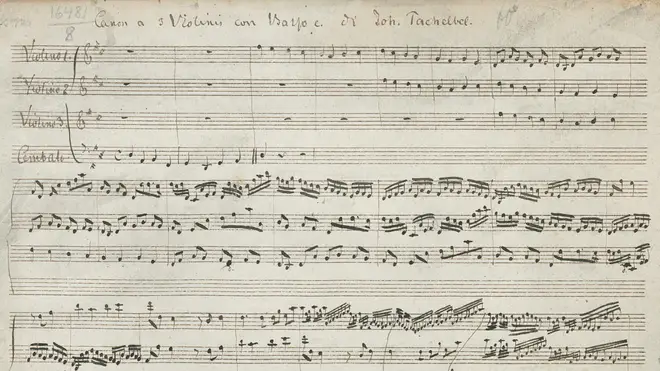On Air Now
Calm Classics with Ritula Shah 10pm - 1am
24 June 2020, 13:23 | Updated: 24 June 2020, 13:27

How Pachelbel's Canon works
It's a wedding classic, beloved by many around the world. But is it really what it says it is? (spoiler: no)
First up, enjoy a beautiful scrolling score of the famous piece, make by Gerubach here. You can find more on his YouTube channel.
Pachebel's Canon uses something called Ground Bass. It's those eight notes you hear in the cello part. In a Canon a short bass line is repeated over and over again with more elaborate parts gradually layered on top in strict counterpoint (where layers of notes fit together perfectly).
This form was very common in the Renaissance and Baroque eras. You'll also hear a lot of use of this sort of thing in 20th-century jazz and today's hip-hop.

Like canons, chaconnes also use ground bass. However, there's an added complexity: the music that's played over that bass-line resembles sets of musical variations, running musical ideas though a variety of moods, tempos and styles.
Often, like in the case of Bach's great D minor Chaconne for solo violin, variations are grouped around sets of notes and melodies (for example, a group of semi-quavers, a group of quarter notes). Keep this in mind...
To bring this back to the layered ideas in Pachelbel's Canon: some music scholars have pointed out that rather than just a canon with changes every two bars, each group is actually four bars with a different identity – closer to variations.
You can take a look at the full score here, but here's a summary of the sort of groups of ideas that are happening every four bars, each like a variation
Ground bass theme (2 bars)
Variations
1. (bars 3–6) groups of crochets
2. (bars 7–10) groups of quavers
3. (bars 11–14) groups of semi-quavers
4. (bars 15–18) jumping crochets
5. (bars 19–22) semi and demisemi-quaver paterns
6. (bars 23–26) staccato with quaver and rests
7. (bars 27–30) semi-quavers
8.(bars 31–38) repetitive semi-quaver patterns
9.(bars 39–42) dotted rhythms
10.(bars 43–46) dotted rhythms with semi-quavers
11.(bars 47–50) syncopated crochets
12.(bars 51–56) quaver octave leaps
These musicologists claim these groups are half strict counterpoint (like a canon), and half variation (like a chaconne).

Pachelbel Canon in D Major - the original and best version
Half-canon/half chaconne, it's quite technical, but the genius of Pachelbel and this abiding work is how he makes it sound just so natural, organic and enjoyable. Next time you hear it at a wedding, you can turn to your neighbour and impress them with your musical factoid.